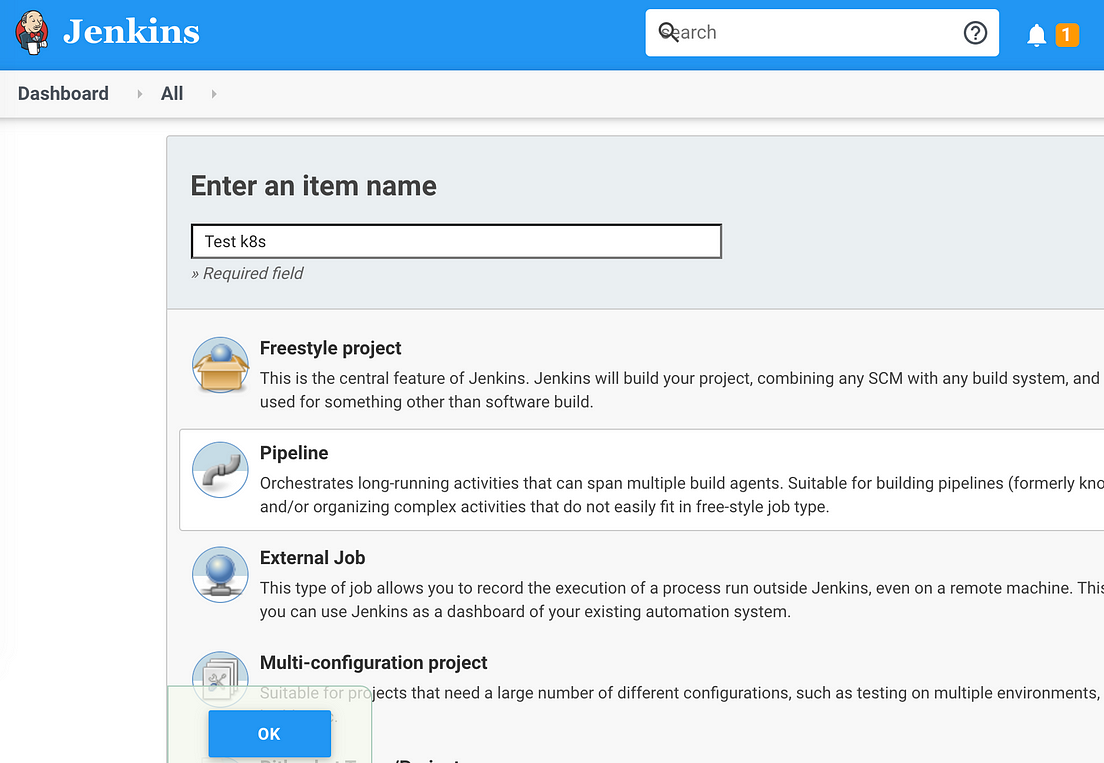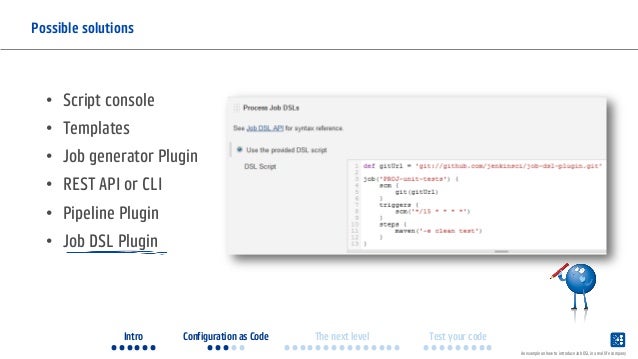44 jenkins node multiple labels
How to Configure Docker in Jenkins {Step-by-Step Guide} 1. Select Manage Jenkins in the menu on the left side of the Jenkins dashboard. 2. Click Manage Plugins in the Manage Jenkins window. 3. Select the Available tab in the Plugin Manager window. 4. Type Docker in the search field, and select the box next to the Docker plugin that appears in the search results. 5. oss-sec: Multiple vulnerabilities in Jenkins plugins These vulnerabilities allow attackers to connect to an attacker-specified URL. SECURITY-2655 / CVE-2022-29049 promoted builds Plugin provides dedicated support for defining promotions using Job DSL Plugin. promoted builds Plugin 873.v6149db_d64130 and earlier does not validate the names of promotions defined in Job DSL.
High Availability with a Scalable Jenkins Kubernetes Deployment Running Jenkins in standalone mode will be problematic if you have multiple busy build processes. You can use container orchestration such as a scalable Jenkins Kubernetes deployment to solve this issue.. The scalable Jenkins deployment allows you to run builds in parallel mode with self-healing support. Each Jenkins build will be faster, too, since running in a distributed environment.
Jenkins node multiple labels
Limiting Jenkins pipeline to running only on specific nodes You also can apply multiple labels with or (||) or with and (&&) operator. Running the job on any of the nodes which has label X or label Y : agent { label 'X || Y' } devopscube.com › jenkins-build-agents-kubernetesHow to Setup Jenkins Build Agents on Kubernetes Pods - DevopsCube Aug 02, 2021 · Jenkins server running out the Kubernetes cluster. Let’s look at configurations for both scenarios. Jenkins server running inside the same Kubernetes cluster. Since we have Jenkins inside the Kubernetes cluster with a service account to deploy the agent pods, we don’t have to mention the Kubernetes URL or certificate key. Jenkins Architecture Explained - Beginners Guide - DevopsCube Jenkins agents are the worker nodes that actually execute all the steps mentioned in a Job. When you create a Jenkins job, you have to assign an agent to it. Every agent has a label as a unique identifier. When you trigger a Jenkins job from the master, the actual execution happens on the agent node that is configured in the job.
Jenkins node multiple labels. Jenkins plugins Multiple Vulnerabilities (2022-04-12) | Tenable® Jenkins plugins Multiple Vulnerabilities (2022-04-12) ... (CVE-2022-29043) - Jenkins Node and Label parameter Plugin 1.10.3 and earlier does not escape the name and description of Node and Label parameters on views displaying parameters, resulting in a stored cross-site scripting (XSS) ... plugins.jenkins.io › nodejsNodeJS | Jenkins plugin NodeJS version 1.0 has adapted its code to the most recent Jenkins API (1.6xx). If also EnvInject is installed you will fall in JENKINS-26583 that corrupts setup of the nodejs installation bin folder into PATH environment. In this case consider if update or not or use an own build from this branch until the JENKINS-26583 will not be fixed. Jenkins Primary (Controller) and Secondary (Agent) Node Relationship For example, I have the following scenario. Primary Node: - Jenkins-Primary-A # located in united states - Jenkins-Primary-B # located in singapore Secondary Node (for Jenkins-Primary-A): - Jenkins-Secondary-A1 # label Alpha-1 - Jenkins-Secondary-A2 # label Alpha-1 - Jenkins-Secondary-A3 # label Alpha-2 Secondary Node (for Jenkins-Primary-B): - Jenkins-Secondary-B1 # label Beta-1 - Jenkins-Secondary-B2 # label Beta-1 - Jenkins-Secondary-B3 # label Beta-1 - Jenkins-Secondary-B4 # label Beta-2 › doc › pipelinePipeline Examples def labels = [' precise ', ' trusty '] // labels for Jenkins node types we will build on def builders = [:] for (x in labels) { def label = x // Need to bind the label variable before the closure - can't do 'for (label in labels)' // Create a map to pass in to the 'parallel' step so we can fire all the builds at once builders[label] = { node ...
How to Scale Master and Slave Architecture using Jenkins? (CI/CD: Part ... You may know master node in the Master-Slave architecture of Jenkins can assign a label to determine which slave node can run specific jobs. However, how to smoothly dispatch multiple build evens... How to run multiple stages on the same node with declarative Jenkins ... Jenkins selects one of the nodes in "Stage 1" based on the label and uses the same node in "Stage 2" because the variable windowsNode was updated to the node selected in "Stage 1". Actual Behaviour "Stage 2" sometimes runs on the same and sometimes on a different node than "Stage 1". See the output below. Jenkinsfile Jenkins Environment Variables: Ultimate Guide - Knowledge Base by ... In Jenkins, any pipeline or job can access and read global environment variables. To add a new global environment variable using the Jenkins dashboard: 1. On the left-hand side of the Jenkins dashboard, click Manage Jenkins. 2. Under the System Configuration section, click Configure System. Jenkins Configuration - How to manage it and configure Global ... - TOOLSQA Whenever there is a build that can be done by using this node, Jenkins will use it. Only build jobs with label expressions matching this node: In this mode, Jenkins will only build a project on this node when that project is restricted to certain nodes using a label expression, and that expression matches this node's name and/or labels. This allows a node to be reserved for certain kinds of jobs.
Multi-Cluster Example | Jenkins X - Cloud Native CI/CD Built On Kubernetes An example how to build a multi-cluster environment using GKE/GSM/DNS. This is an example on how to build a multi-cluster environment having two separate cluster repos (i.e. 'dev' and 'prod'). The steps will include building a GKE/GSM/DSN environment from scratch for both environments, and deploying projects to staging and the remote ... Integrate mobile tests and Jenkins - admhelp.microfocus.com For details, see Using Jenkins agents in the Jenkins documentation. Select Manage Jenkins > Manage Nodes and click the Configure icon to open the Configure page node. Enter the labels in the Labels fields. Make sure that the agents have different labels. You can also use the values assigned to the agents from the previous steps. Tutorial - Scale Jenkins deployments with VM running in Azure Labels: Labels are used to group semantically related agents into one logical group. For example, you could define a label of UBUNTU for all your agents running the Ubuntu distro of Linux. Launch method : There are two options to start the remote Jenkins node: Launch agents via SSH and Launch agent via execution of command on the master : wiki.jenkins.io › display › JENKINSJenkins : Publish Over May 02, 2019 · Sets NODE_NAME to the value specified if the environment variables contain a variable NODE_NAME that does not have a value. If you are running on multiple nodes and you have executors on the master Jenkins and the build may occur on the master, then if you set this option, the NODE_NAME for the master will be set to the configured value.
plugins.jenkins.io › nodelabelparameterNode and Label parameter | Jenkins plugin Node Parameter. Define a list of nodes on which the job should be run. A default node used for scheduled jobs can be defined. You are able to configure the job to run one after the other or even concurrent. In case multi node selection was disabled, you get a drop-down to select one node to execute the job.
github.com › jenkinsci › kubernetes-pluginGitHub - jenkinsci/kubernetes-plugin: Jenkins plugin to run ... Fill in the Kubernetes plugin configuration. In order to do that, you will open the Jenkins UI and navigate to Manage Jenkins -> Manage Nodes and Clouds -> Configure Clouds -> Add a new cloud -> Kubernetes and enter the Kubernetes URL and Jenkins URL appropriately, unless Jenkins is running in Kubernetes in which case the defaults work.
ssh-slaves-plugin/CONFIGURE.md at main - GitHub Labels: Labels (or tags) are used to group multiple agents into one logical group. You will use them to select it as agent for a build. Multiple labels must be separated by a space. Usage: Controls how Jenkins schedules builds on this node. Use this node as much as possible: This is the default setting. In this mode, Jenkins uses this node freely.
jenkins node multiple labels focus on the family voter guide 2022 oregon. Menu. pleasant local schools calendar 2022-2023; rhode island house districts

Building the CI/CD of the Future, create your first pipeline in Jenkins | by Igor Zhivilo | Jun ...
Jenkins : Extra Columns Plugin This is a general listview-column plugin that currently contains the following 16 columns: Build Description, Build Duration, Build Parameters, Configure Project button, Disable/Enable Project button, Job Type, Last Build Node, Last/Current Build Console output, Last Project Configuration Modification, Periodic build trigger, Project Description, SCM Type, Slave or label restriction, Test ...
Jenkins Pipeline - Different types of CI pipelines and stages - TOOLSQA Firstly, from the Jenkins dashboard, click on New Item on the left panel. Secondly, enter the name for your pipeline, select Pipeline from the list. After that, click OK. After that, go to the Pipeline tab, and from the Definition, the dropdown selects the Pipeline script. The next step is to write your pipeline code in the web UI provided by ...
How to Setup Master and Slave Architecture using Jenkins? (CI ... - Medium Labels are used for Jenkins Master to assign which Jenkins Slave to run CI/CD. Remember you need to check the slave node's connection status is fine or not on the dashboard. If not, check the ...

![[JENKINS-41710] Annotate test results with a test run name - Jenkins JIRA](https://issues.jenkins-ci.org/secure/attachment/35754/Screen Shot 2017-02-03 at 15.45.05.png)



Post a Comment for "44 jenkins node multiple labels"